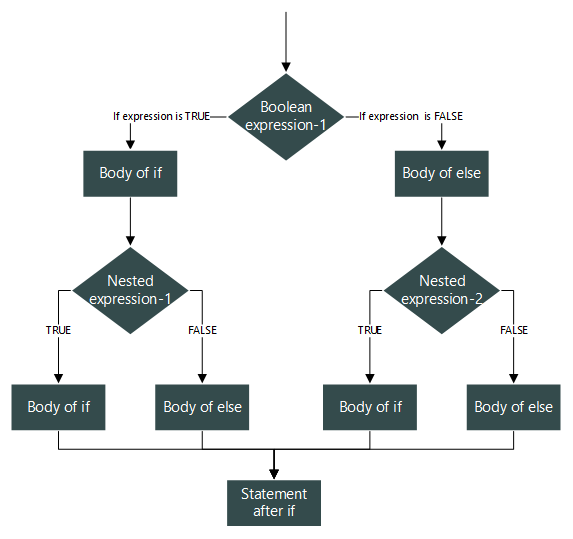Simple if and if...else...if statements provide a great support to control programs flow. Simple if is single condition based task i.e. “if some condition is true, then do the task”. In contrast if...else...if statement provides multiple condition checks i.e. “if some condition is true, then do some task. If the condition is false, then check some other condition and do some task. If all conditions fails, then do some default task.”
Read more –
Consider a situation, where you want to execute a statement based on multiple levels of condition check. For example – At airport there are multi-levels of checking before boarding. First you go for basic security check, then ticket check. If you have valid ticket, then you go for passport check. If you have valid passport, then again you will go for security check. If all these steps are completed successfully, then only you can board otherwise actions are taken by the authority.
Nested if...else statements has ability to control program flow based on multiple levels of condition.
Syntax of nested if...else statement
if (boolean_expression_1)
{
if(nested_expression_1)
{
// If boolean_expression_1 and
// nested_expression_1 both are true
}
else
{
// If boolean_expression_1 is true
// but nested_expression_1 is false
}
// If boolean_expression_1 is true
}
else
{
if(nested_expression_2)
{
// If boolean_expression_1 is false
// but nested_expression_2 is true
}
else
{
// If both boolean_expression_1 and
// nested_expression_2 is false
}
// If boolean_expression_1 is false
}Note: In the above syntax I have nested one if...else statement inside another. However, any two decision statement can be inside other.
Flowchart of nested if...else statement

Example program of nested if...else statement
Let us write a program to input three numbers from user. Find maximum between given three numbers.
/**
* C program to find maximum between three numbers
*/
#include <stdio.h>
int main()
{
/* Declare three integer variables */
int num1, num2, num3;
/* Input three numbers from user */
printf("Enter three numbers: ");
scanf("%d%d%d", &num1, &num2, &num3);
if(num1 > num2)
{
if(num1 > num3)
{
/* If num1>num2 and num1>num3 */
printf("Num1 is max.");
}
else
{
/* If num1>num2 but num1<num3 */
printf("Num3 is max.");
}
}
else
{
if(num2 > num3)
{
/* If num1<num2 and num2>num3 */
printf("Num2 is max.");
}
else
{
/* If num1<num2 and num2<num3 */
printf("Num3 is max.");
}
}
return 0;
}Output of the above program
Enter three numbers: 10
20
30
Num3 is max.Let us now understand the working flow of above program.
- I think, you must be clear upto
scanf()statement. Otherwise read in detail about basic input/output in C. - Suppose user inputs three numbers as num1=10, num2=20 and num3=30.
- The first outer
ifconditionif(num1 > num2)isfalsesince 10 > 20 isfalse. Hence, outerifstatement is skipped, executing the outerelsepart. - Inside the outer
else, conditionif(num2 > num3)is alsofalse, since 20 > 30 isfalse. Hence, the innerifstatement is skipped, executing innerelsepart. - Inside the inner
elsethere is nothing much to do. Just a simpleprintf()statement, printing “Num3 is max.”
Before moving to next tutorial, must try some exercises based on if...else statement.
Practice exercise – if…else programming exercises in C.
